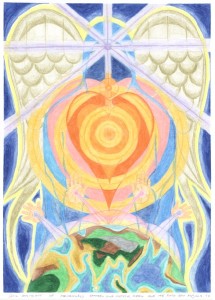The series of meditation classes that I am teaching at the moment has got me thinking about different ways in which you can express enlightenment in your daily life. Here is a profile of five enlightened powers that, if consciously practised together will make your own attempts to embody enlightenment in the market place more powerful:
The five types of power are:
- The power of embodiment
- The power of devotion
- The power of affirmation and visualization
- The power of energy
- The power of karmic action
The power of embodiment – The basic practice here is remembering that you are, in essence a spark of Universal spirit experiencing (temporarily) a physically embodied life on Earth as a human. Whatever situation you find yourself in, grounding your awareness in your true identity and not getting caught up in your small or egoic identity is the power of embodiment. Wherever you are, remember WHO you are!
The power of devotion – This power is the power of invoking prayers to forces greater than oneself regarding any situation that you may be in. The power of devotional prayer connects higher and deeper energies into the situation, and enables them to participate in the event more directly, thus increasing the chances of a more enlightened outcome (See my article on “Why worry when you can pray?” ).
Another aspect of this power could be said to be your devotion to your highest ideal and highest outcomes, not settling for second best so to speak.
The power of affirmation – This power is really a mental training. It involves paying attention to the thoughts and images that you are having, and ensuring that as far as possible they are affirming the highest and best outcome for any given situation. Our thoughts and imagination have tremendous unseen power to influence events one way or another.
The power of energy – This power entails being aware of the subtle energy present in your body and in the environment, and learning to develop and maintain as harmonious, positively powerful and stable subtle body energy as you can at all times. Simply being a point of stable, expansive enlightened energy in any situation will be of help, even if we do or say nothing.
The power of karmic action – This is choosing to physically act and speak in a way that is congruent with the above four enlightened powers, so that the actual daily actions that you engage in are a reflection of the higher intentions that you have been developing.
A five minute meditation for engaging the five enlightened powers in your daily life:
If you do this exercise once a day over the next 7 days, it will give you a feel for how to engage the five powers in any given action.
– Minute 1 – Embodiment: Select the life situation that you want to engage the five enlightened powers with. Visualize yourself in that situation. Breathe deeply into the core of your being and body, find the formless, timeless space of pure awareness in your heart that is your True or Universal Self. Ground yourself in the awareness that this is your true identity.
– Minute 2- Devotion: Offer a prayer in whatever manner feels appropriate for the highest good of the situation. Invoke any higher or greater universal powers into the situation and request their help. Give them permission to participate fully in working toward the best outcome.
– Minute 3 – Affirmation: Offer your highest and most encouraging thoughts regarding the situation. For this time see, think and visualize the highest good and the best outcome
– Minute 4 – Energy: Feel the subtle energy and light vibration in your body as strong, balanced, harmonious and stable. See this energy spreading out into the situation and the energies of all the people involved. Feel and experience this strong balanced subtle force flowing in the dynamic of the whole scene.
– Minute 5 – Karmic Action: For the last minute think about practical things that you may be able to do or say to take the situation forward. Make a metal note of when and where you are going to try and engage in these practical actions.
Conclude with a dedication that the energy of all the five forces that you have generated in your meditation should be a cause for the most enlightened outcome possible!
Finnish.
© Toby Ouvry 2010 you are welcome to use this article, but you must seek Toby’s permission first! Contact info@tobyouvry.com


